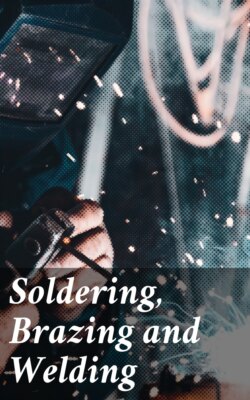Читать книгу Soldering, Brazing and Welding - Группа авторов - Страница 21
На сайте Литреса книга снята с продажи.
Copper Bits.
ОглавлениеTable of Contents
—The soldering bit or bolt (miscalled an “iron”) carries a pointed lump of copper at the end (Fig. 2), riveted in, or alternatively, in small sizes, screwed on to the shank. Some bits are pivoted (see Fig. 3) to enable them to point at various angles for dealing with difficult situations.
A home-made bit (Figs. 4 and 5) may be made by drilling and tapping a short length of 11⁄2-in. or 2-in. square copper to receive the screwed end of a rod of 5⁄16-in. iron, the copper being afterwards heated and drawn to a point or to a blunt edge as preferred. This forms a good bit for most ordinary purposes. An axe-head or hatchet bit is shown in Fig. 6; the copper bolt is riveted in the eye of the iron rod, the bit, however, being free to revolve, as this is essential when making joints in heavy lead pipe, for which purpose it is principally used. Fig. 5 represents a bit which is a combination and modification of the two others, and it is largely used for the internal soldering of bottoms of large drums, milk churns, etc., where great local heat is required.
Fig. 4.—Home-made Soldering Bit
Fig. 5.—Bit for Internal Soldering, etc.
Fig. 6.—Hatchet Soldering Bit
As to the size of bit required, for ordinary small work the straight type should not be less than 8 oz. or 10 oz. (weight of the actual copper).
Two bits are very useful in doing a large job, as the work can then be arranged to progress continuously, one bit heating while the other is in use.
A bit suitable for quite light work can be easily made by drilling and tapping a piece of copper, say 1⁄2 in. by 1⁄2 in. by 11⁄2 in. long, either in the end or in the side, for a 3⁄16-in. steel rod 12 in. long, a handle being then fitted at the other end.
In the “Tinol” telescopic soldering bit for amateurs’ use, the handle is in three parts: (a) the actual wooden handle bushed with metal, and provided with a set-screw shaped like a screw eye, and therefore easily turned; (b) a steel tube which telescopes into the first part, and which is also provided with a set-screw; and (c) a short rod, having at one end a hatchet-shaped copper bit. The extreme length of the tool is 12 in., and the length, when the parts are telescoped together, is about 5 in.
The “Fluxite” bit is larger and heavier. It has a hollow cast-iron handle, perforated to dissipate the heat, threaded internally at one end to receive the screwed end of the iron stem, only 5 in. or so in length, which at the other end screws into an adapter or holder which, in turn, receives the screwed end of the copper bolt, itself about 4 in. long. The bit is taken to pieces in a few moments, and is quite a workmanlike tool.
Fig. 7.—Spirit-heated Bit
